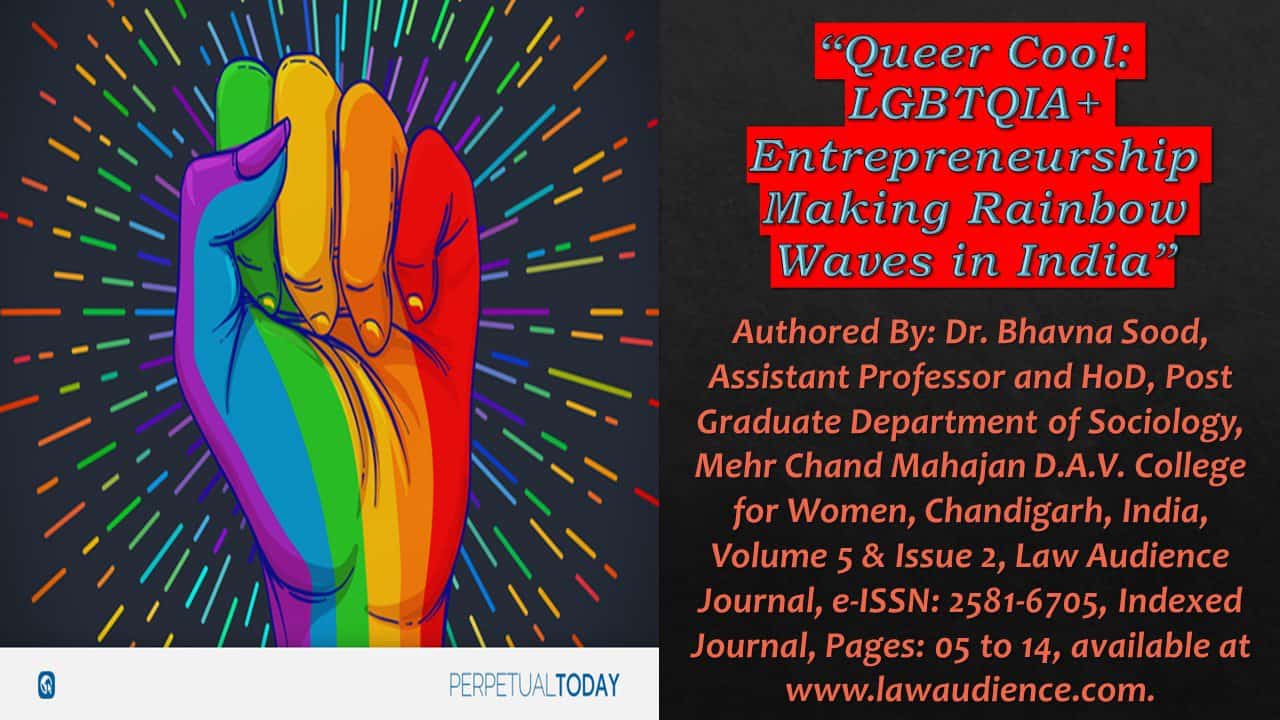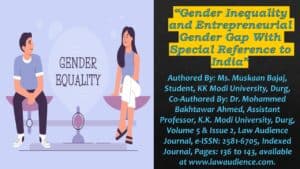Click here to download the full paper (PDF)
Authored By: Dr. Bhavna Sood, Assistant Professor and HoD, Post Graduate Department of Sociology, Mehr Chand Mahajan D.A.V. College for Women, Chandigarh, India,
Click here for Copyright Policy.
ABSTRACT:
“An entrepreneur is one who takes calculated risks, to start an out of the box venture and they play a key role in any economy. The word “entrepreneur” comes from the French verb entreprenerd which means “to undertake.” Starting a business is challenging to every aspiring entrepreneur but it’s even harder to overcome for LGBTQIA+ entrepreneurs. Entrepreneurs enter the market because they love what they do, believe their product will have a positive impact, and hope to make profits from their efforts. While there’s much to celebrate about milestones achieved for the LGBTQIA+ community, there’s still much more work to do in the business world for LGBTQIA+ equality. With Gen Z quickly becoming both the most queer and entrepreneurial generation yet, it is no surprise that queer entrepreneurs play an increasingly vital part in our economy. In 2014 the first count of the third gender came to be 4.9 lakhs (TOI), most of them coming from the Northern state of Uttar Pradesh”.
Keywords: Entrepreneurship, Transgender, Third Gender.
Objective:
This paper will focus on the issues of the third gender and explore how they have created a place in the business market in India and doing good.
Methodology:
This paper is exploratory and descriptive in nature. Secondary sources of data were used from books, articles, journals, e-sources, etc to understand how inclusive the Indian society has become of the third gender.
I. INTRODUCTION:
“Change will not come if we wait for some other person or some other time. We are the ones we’ve been waiting for. We are the change that we seek.” – Barack Obama
India is the largest democracy in the world but it continues to struggle with societal stigmas related to moral values, and especially to sexual orientation. The life of the LGBT community is hampered by both the society’s conservative values and the legacy of British colonial legislation on criminalization of transgenders.
II. HISTORY:
In the Mughal era, they occupied high positions as many influential figures such as officials, administrators, generals, and guardians of harems. Hijras were considered trustworthy, loyal, clever, and had access to all members of the populace. In 1871, the first Criminal Tribes Act (CTA) was passed by British India’s governor-general (the supreme ruler of the colonial authorities) which targeted ‘eunuchs’ (a stigmatizing colonial term for transgender). According to the Rig Veda, in Hindu mythology, three types of genders have been considered— The Male, that is the Purush, the Female, that is the Prakriti and the third gender that is the Tritiya Prakriti. The existence of transgender women in India is not new. Reference to trans women can be found in the ancient Hindu scripture especially Mahabharata, which serves as the philosophical foundation of current Indian society. During the eighteen-day battle of Kurukshetra, Prince Aravan, son of Arjuna, decided to sacrifice himself to secure the victory of Pandavas. His last wish before dying on the battlefield was to get married. When no woman came forward to marry him, Krishna (one of many deities in Hinduism) transformed himself into a woman, Mohini, in order to fulfill Prince Aravan’s wish. In the spring of each year, thousands of trans women gather in Koovagam village, about 120 kms south of Chennai (Madras), to reenact the wedding of Mohini and Aravan as portrayed in Mahabharata (Koovagam festival). During the festival, priests of the local temple perform a symbolic ritual wedding by giving them thali—the sacred thread traditionally tied around a woman’s neck during the Hindu wedding ceremony in Tamil Nadu. The following day, transgender women shun their symbolic thali and mourn the death of Aravan. Such religious festivals and symbolic rituals allow transgender-woman to foster community, maintain traditions, and preserve their identities. Like the rest of Indian society, the transgender community has a hierarchical social structure. Across the country, there are several clans. Each clan is headed by a Nayak (supreme leader); each community within the clan has a guru (master); and under each guru there are a number of chelas (disciples).
III. DEFINITION:
Eunuchs/Hijras/Transgender/Third Gender is succinctly described as an umbrella term for persons who are not cisgender, whose gender identity does not conform to their biological sex. In the layman language, it means that a person who was born and described as male at his birth but later developed the organs of female or a person who was born and described as female at his birth but later developed the organs of the male or a person who, at his birth had both the organs of male and female is described to be a transgender. Hijras: They are natural males who dismiss their manly character at the appointed time to identify either as lady, or not-men, or in the middle of man and lady, or neither man nor lady. Enunch: It refers to an emasculated male & intersected to a person whose genitals are ambiguous male at birth. Aravanis: Biological Males who self-identify as a woman trapped in a male’s body. Kothis: Heterogeneous group of people who can be described as biological males but their attributes show varying colours of femininity. Shiv-Shakthis: Males who are controlled by or especially near goddess and have ladylike sexual orientation articulation. 1 (2014) 5 SCC 438 2 THE TRANSGENDER PERSONS (PROTECTION OF RIGHTS) BILL, 2016, India.
IV. CONCEPTS:
Enterprise is composed of individuals and physical assets with a common goal of generating profits. An individual who creates an enterprise is called an entrepreneur. The act of establishing an enterprise is known as entrepreneurship. It is a process of organising and managing a business venture, taking calculated risks, bringing innovation, generating employment, creating and implementing new ideas and creative solutions. The success and failure of an enterprise depends on the efficiency of the entrepreneur, who needs to adapt to the changing markets, industries and economy. According to McClelland “Entrepreneurship is doing things in a better way and decision-making under the condition of uncertainty”.
V. CHARACTERISTICS OF ENTREPRENEURS:
For a person to be a successful entrepreneur has to have these following characteristics:
- Versatile
- Flexible
- Money Savvy
- Resilient
- Focused
- Business Smart
- Communicator
- Innovation
- Creativity
- Dynamism
- Self-Motivation
- Problem Solving
- Leadership
- Time Management
- Risk Taking
- Visionary
VI. SIGNIFICANCE OF ENTREPRENEURSHIP:
- Improves the standard of living
- Facilitates the transfer of technology
- Facilitates the proper utilization of resources
- Restructuring and transforming the economy
- Brings dynamism in industries
- Expands international markets
- Balances economic growth
VII. DISCOVERY THEORY AND CREATION THEORY OF ENTREPRENEURSHIP:
Discovery theory maintains that opportunities exist objectively independent of entrepreneurs, while creation theory argues that opportunities originate from the action of individuals. In case of the transgenders its clearly the creation theory that seems most applicable. They are showcasing their talents on social media platforms in the form of sites, blogs and have created an entire world of their own catering to community specific needs.
VIII. MODELS OF ENTREPRENEURSHIP DEVELOPMENT/SCHOOLS OF ENTREPRENEURSHIP THOUGHTS PSYCHO-SOCIAL MODEL:
Psychological theories of entrepreneurship put emphasis on the emotional and mental aspects of the individuals that drive their entrepreneurial activities (Baum, Frese, & Baron, 2014). Three of the most popular psychological theories of entrepreneurship today include: McClelland’s theory of motivation explaining the need for achievement that often regulates the actions of an entrepreneur. Rotter’s theory focuses on locus of control whether internal or external that influences entrepreneurial actions and Action regulation theory highlights that the performance of entrepreneurs depends on their actions
VIII.I SOCIOLOGICAL MODEL:
This model suggests that the entrepreneurial qualities of an individual or a group remain ingrained within the society to which a person belongs to. This perspective of society is in turn influenced by the religious and ethical beliefs it subscribes to (Jackson, 1983; Rao and Singh, 2018).
VIII.II POPULATION-ECOLOGY MODEL (PEM):
Hannan and Freeman’s (1977) population ecology theory rests on the assumption that environments can only handle a fixed number of organizations of each type. After a certain point is reached, there are diminishing returns to density that eventually balance out through the mortality of organizations.
IX. TYPES OF ENTREPRENEURS:
Not every entrepreneur is the same and not all have the same goals.
IX.I BUILDER:
Builders seek to create scalable businesses within a short time frame. Builders typically pass $5 million in revenue in the first two to four years and continue to build up until $100 million or beyond. These individuals seek to build out a strong infrastructure by hiring the best talent and seeking the best investors. They have temperamental personalities that are suited to the fast growth they desire but can make personal and business relationships difficult.
IX.II OPPORTUNIST:
Opportunistic entrepreneurs are optimistic individuals with the ability to pick out financial opportunities, get in at the right time, stay on board during the time of growth, and exit when a business hits its peak. These types of entrepreneurs are concerned with profits and the wealth they will build, so they are attracted to ideas where they can create residual or renewal income. Because they are looking to find well-timed opportunities, opportunistic entrepreneurs can be impulsive.
IX.III INNOVATOR:
Innovators are those rare individuals that come up with a great idea or product that no one has thought of before. Think of Thomas Edison, Steve Jobs, and Mark Zuckerberg. These individuals worked on what they loved and found business opportunities through that. Rather than focusing on money, innovators care more about the impact that their products and services have on society. These individuals are not the best at running a business as they are idea-generating individuals, so often they leave the day-to-day operations to those more capable in that respect.
IX.IV SPECIALIST:
These individuals are analytical and risk-averse. They have a strong skill set in a specific area obtained through education or apprenticeship. A specialist entrepreneur will build out their business through networking and referrals, resulting in slower growth than a builder entrepreneur.
X. TYPES OF ENTREPRENEURSHIPS:
As there are different types of entrepreneurs, there are also different types of businesses they create. Below are the main different types of entrepreneurships.
Small-Business is the idea of opening a business without turning it into a large conglomerate or opening many chains. A single-location restaurant, one grocery shop, or a retail shop to sell your handmade goods would all be an example of small business entrepreneurship.
These individuals usually invest their own money and succeed if their business turns a profit, which they live off of. They don’t have outside investors and will only take a loan if it helps continue the business.
Scalable Startup These are companies that start with a unique idea; think Silicon Valley. The hopes are to innovate with a unique product or service and continue growing the company, continuously scaling up as time moves on. These types of companies often require investors and large amounts of capital to grow their idea and reach multiple markets.
Large-Company entrepreneurship is a new business division created within an existing company. The existing company may be well placed to branch out into other sectors or it may be well placed to become involved in new technology.
CEOs of these companies either foresee a new market for the company or individuals within the company generate ideas that they bring to senior management to start the process.
XI. SOCIAL ENTREPRENEURSHIP:
The goal of social entrepreneurship is to create a benefit to society and humankind. They focus on helping communities or the environment through their products and services. They are not driven by profits but rather by helping the world around them. BeUnic is a queer owned, community driven platform for LGBTQ+ creators and entrepreneurs. It curates products created by Queer entrepreneurs.
XII. QUEER QOOL EXAMPLES:
- At a site called LBB which has people from bangalore such as Angelo Vegan Cheese-Aditya Angelo Fernandes is an artist and a vegan cheese maker. Strawbabie- Sukku discovered her passion for slow fashion and creating unique jewellery in the lockdown, cut to now, you can find a small collection of handmade necklaces, earrings, very cute stickers, trinket dishes, and 100 per cent authentic crystals. CTRL+P is a lifestyle brand, which sells pride merch (beyond Kristy rainbows and flashy flags), sustainable products, cards, journals, notebooks, and cute socks. Yogam Pottery-began in 2018 as a desire to celebrate passion and individuality. Cosmic Jalebi has over thirty prints to choose from and all of them are quirky, colourful, and expressive. (https://lbb.in/bangalore/indian-queer-owned-businesses-and-creators/)
2. PeriFerry: PeriFerry is an ally‑owned, social impact startup focused on creating inclusive job opportunities for the transgender community. They provide awareness and sensitisation services to organisations building a culture of LGBTQ+ inclusion.
- Serenity Thrifts: is a sustainable store, selling pre-loved, thrifted, and upcycled clothes. The firm has recently started taking custom orders for hand-painted clothing.
- Tats and Illos: is owned and run by Ishana, a queer multi-media artist based in Mumbai. Ishana specialises in illustration & animation and translates her work into hand-poked tattoos.
5. Leeedoodles:Lee is a queer digital artist, owning @leeedoodles. She creates and sells original designs like illustrations, logos, and creative content for social media. She also makes custom stickers and art prints, and is open for commissions.
6. Argha’s Creations: Argha’s Creations is run by Argha Naskar, Kolkata based 17-year-old (he-him/they-them) selling customized chocolates, BonBons, Bengali platters, cakes and other delicacies.
7. Shriyaaarghart: Shriya (any pronouns), is a bisexual artist who creates their work in a variety of mediums. Whether you’re looking for a crocheted item, an embroidery hoop, crocheted jewellery, a custom art piece, resin charms, or even some original fiction, they can provide all of these things.
- The Third Eye Cafe in Mumbai offers a fresh perspective on fine dining. The restaurant provides good value for money because it serves a variety of cuisines. Its staff, however, is what sets it apart. They are all transgender.
These stories are just a reflection of millions more building change for the LGBTQIA community. Founded as an online collective, QueerBazaar has now transformed into a full-fledged organisation that works for the LGBTIAQ+ community. The platform has serviced more than 20,000 orders and is poised to grow further thanks to a fresh infusion of funds from its donors.
XIII. CONCLUSION:
This article would be incomplete if the name of Laxmi is not mentioned. Laxmi Narayan Tripathi is a transgender rights activist, Hindi film actress and a Bharatanatyam dancer based in Mumbai, In 2002, Laxmi went on to become one of the founding members of the Dai Welfare Society, an organisation that works for the transgender community and represented Asia Pacific in the UN in 2008, where she spoke of the plight of sexual minorities in the society. Breaking all conventional notions surrounding beauty pageants pertaining to gender, she launched the Indian Super Queen beauty pageant in 2010, which is going strong! She is by far the strongest example of how talented this community is and its time now that we stand up for them and give them respect and support their ventures. On one hand, according to professor Premilla D’Cruz, who teaches organisational behaviour at the Indian Institute of Management Ahmedabad, most organisations have neither embraced gender inclusivity nor put any particular effort into employing the LGBTQIA+ community. While on the other hand, some firms, like Zomato, are keen to hire more LGBTQIA+ members to build a vibrant gender-neutral workforce. The LaLit Group of Hotels has been a flagbearer for gender equality, proudly flaunting its support of an inclusive workplace that offers the LGBTQIA+ community a friendly environment with several opportunities to grow and thrive. The Transgender Persons (Protection of Rights) Act, 2019, was approved by President Ramnath Kovind on December 5, 2019. It is a small step towards achieving something big. Development and equality in distribution of resources will be futile and inefficient if it does not include all sections of society, especially minorities. Any intervention or policy to empower transgenders will only be effective when welcomed by the rest of the population. This clearly indicates a need for a shift in attitude of people and policymakers need to be more sensitive and mindful so as not to encourage pre-existing discrimination.
“There’s Nothing Wrong with You,
There’s a lot Wrong with the World You LIVE IN” Cris Colfer
Cite this article as:
Dr. Bhavna Sood, “Queer Cool: LGBTQIA+ Entrepreneurship Making Rainbow Waves in India”, Vol.5 & Issue 2, Law Audience Journal (e-ISSN: 2581-6705), Pages 05 to 14 (28th May 2023), available at https://www.lawaudience.com/queer-cool-lgbtqia-entrepreneurship-making-rainbow-waves-in-india/.
References:
- https://www.investopedia.com/terms/e/entrepreneur.asp
- https://blog.ipleaders.in/criminalization-of-transgender-people-in-colonial-india-criminal-tribes-act/
- https://www.thebetterindia.com/106115/list-lqbtq-famous-personalities-pride-month/
- https://www.outlookindia.com/business/gay-and-happy-with-india-inc-corporates-take-pride-in-an-inclusive-workplace-news-205954
- https://www.statista.com/statistics/705970/india-number-of-transgender-people-by-state/
- https://www.illiberalism.org/indias-third-gender/
- http://www.penacclaims.com/wp-content/uploads/2019/02/Apoorva-Kinra.pdf
- https://hr.economictimes.indiatimes.com/news/workplace-4-0/diversity-and-inclusion/how-india-inc-is-ensuring-inclusion-for-lgbtq-employees/89033182
- http://164.100.47.4/BillsTexts/LSBillTexts/Asintroduced/210_2016_LS_Eng.pdf Volume 5, January 2019 ISSN 2581-5504 www.penacclaims.com Page 3.



